
Grigori Yefimovich Rasputin was a Russian mystic and holy man. He is best known for having befriended the imperial family of Nicholas II, the last Emperor of Russia, through whom he gained considerable influence in the final years of the Russian Empire.

The Neva is a river in northwestern Russia flowing from Lake Ladoga through the western part of Leningrad Oblast to the Neva Bay of the Gulf of Finland. Despite its modest length of 74 kilometres (46 mi), it is the fourth-largest river in Europe in terms of average discharge.

Prince Felix Felixovich Yusupov, Count Sumarokov-Elston was a Russian aristocrat from the Yusupov family who is best known for participating in the assassination of Grigori Rasputin and for marrying Princess Irina Alexandrovna, a niece of Tsar Nicholas II.

Anna Alexandrovna Vyrubova ; 16 July 1884 – 20 July 1964) was a Russian Empire lady-in-waiting, the best friend and confidante of Empress Alexandra Fyodorovna.
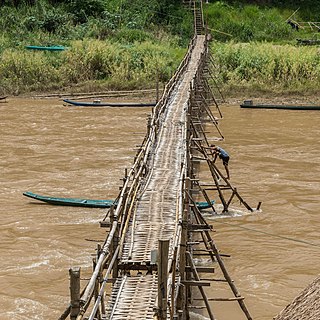
A footbridge is a bridge designed solely for pedestrians. While the primary meaning for a bridge is a structure which links "two points at a height above the ground", a footbridge can also be a lower structure, such as a boardwalk, that enables pedestrians to cross wet, fragile, or marshy land. Bridges range from stepping stones–possibly the earliest man-made structure to "bridge" water–to elaborate steel structures. Another early bridge would have been simply a fallen tree. In some cases a footbridge can be both functional and artistic.

The Petrovsky Stadium is part of a sports complex that consists of a number of buildings, with the stadium being used mostly for football and sometimes athletics. The Grand Sport Arena of the Petrovsky Sport Complex was the home of Zenit Saint Petersburg until 2017 and Tosno in 2017–2018.

Palace Bridge, a road- and foot-traffic bascule bridge, spans the Neva River in Saint Petersburg between Palace Square and Vasilievsky Island. Like every other Neva bridge, it is drawn by night, making foot travel between various parts of the city virtually impossible. It was built by the French firm Société de Construction des Batignolles between 1912 and 1916.
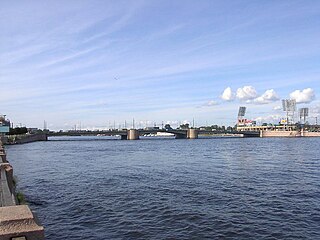
The Little Neva or Malaya Neva is the second largest distributary of the river Neva. The Neva splits into Great Neva and Little Neva near the Spit of Vasilievsky Island, in the historic centre of the city of Saint Petersburg.
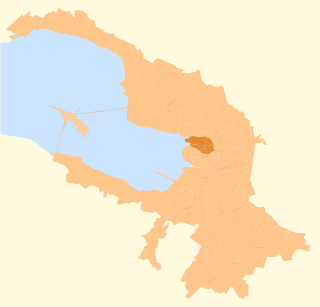
Petrogradsky District is a district of the federal city of St. Petersburg, Russia. It borders the Bolshaya Nevka River in the north and in the east, the Neva River in the south, and areas around the Malaya Neva River in the west. District's population: 130,455 (2010 Census); 134,607 (2002 Census).
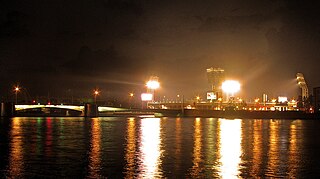
Petrovsky Island is an island in St. Petersburg, Russia, bordered by the Malaya Neva, Malaya Nevka, and Zhdanovka Rivers.
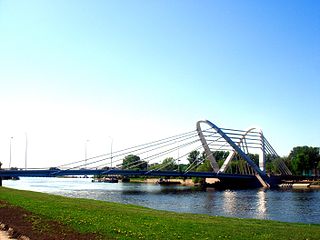
The Little Nevka or Malaya Nevka is the southern distributary of the Great Nevka. The Great Nevka splits into Little Nevka and Middle Nevka near the Kamenny Island's easternmost tip. It is also known for being the dumping ground of the famous Rasputin after his assassination.

Krestovsky Island is a 3.4 km2 island in Saint Petersburg, Russia, between several tributaries of the Neva: the Srednyaya Nevka, the Malaya Nevka and the Krestovka. The island is served by the Krestovsky Ostrov station of Saint Petersburg Metro. Until recently, the western part of the island was occupied by the Maritime Victory Park, where the international Goodwill Games of sports and athletics competition took place in 1994, which was the first large scale post-Soviet Union international event in Russia. A new stadium, Gazprom Arena, is located where Kirov Stadium was. The stadium serves as home for FC Zenit Saint Petersburg.

Petrogradsky Island or Petrograd Island is the third-largest island in the Neva River delta in Saint Petersburg, Russia. Along with Zayachy Island, Aptekarsky Island, and Petrovsky Island, it constitutes the Petrogradskaya Side. It is the administrative center of the Petrogradsky District and hosts a number of universities and research centers, as well as cultural, historical, and recreational facilities.

The Zhdanovka is a short river in the Neva river delta in Saint Petersburg, Russia. It separates Petrogradsky Island from Petrovsky Island.
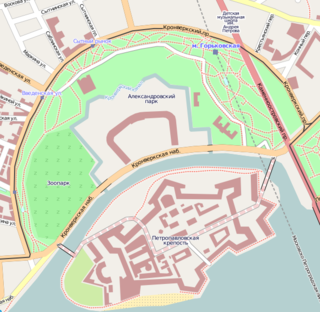
The Kronverksky Strait is a narrow channel separating Petrogradsky and Zayachy islands in Saint Petersburg, Russia. It forms an arc approximately 1 kilometre (0.6 mi) long, about 50 metres (160 ft) wide and 4 metres (13 ft) deep. To the south is Zayachy Island, which is dominated by the Sts. Peter and Paul Fortress, and to the north is the Kronverk on Petrogradsky Island. It is spanned by the Kronverksky Bridge to the east and the Ioannovsky Bridge to the west.

The Malo-Kalinkin Bridge is a bridge in Saint-Petersburg, which connects Kolomna Island and Pokrovsky Island, spanning the Griboyedov Canal. It was built in 1783 by engineer I. Borisov, at the same time that the granite embankments of the canal were being constructed.

Sampsonievsky Bridge, was also known as Freedom Bridge during the 20th century, is a structure located over the Bolshaya Nevka river, St Petersburg, Russia. It links Kuybysheva Street and Finlandsky Avenue. It was named after St. Sampson’s Cathedral. It is 215 metres long and 27 metres wide.

Lazarevsky Bridge is a cable-stayed bridge located in St. Petersburg, Russia. It crosses the Little Nevka River, connecting Krestovsky Island and Petrogradsky Island. It is near Bolshoi Krestovsky Bridge (upstream), and Bolshoi Petrovsky Bridge (downstream). The bridge carries four lanes of road traffic and features an asymmetric design, with cable stays anchored to a pylon on the Krestovsky Island side.
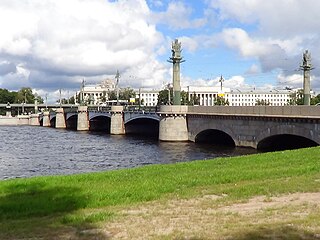
Ushakovsky Bridge is a bridge spanning the Bolshaya Nevka River in Saint Petersburg, Russia named for Admiral Fyodor Ushakov. Originally built in 1786 as a floating pontoon bridge, the bridge was rebuilt between 1847 and 1853 as a multi-span wooden bridge. The bridge was refitted in 1906, 1911, and 1935. The current version of the bridge was constructed between 1953 and 1955. The bridge currently contains 11 spans with the central span being a double-leaf rolling lift. The other spans are bridged over with continuous beams. The bridge's footing is faced with granite. The bridge is 254.8 metres (836.0 ft) long with approaches and 27 metres (88.6 ft) wide.

Kamennoostrovsky Bridge spans the Little Nevka River and connects Aptekarsky Island with Kamenny Island in Saint Petersburg, Russia. Originally constructed as a floating pontoon bridge in 1760. Between 1811 and 1813, Kamennoostrovsky Bridge became the first seven span timber arch bridge in Russia. In 1859, the bridge was improved with the addition of strut-supported spans. In 1952, the bridge was rebuilt to its current design with five spans.





















